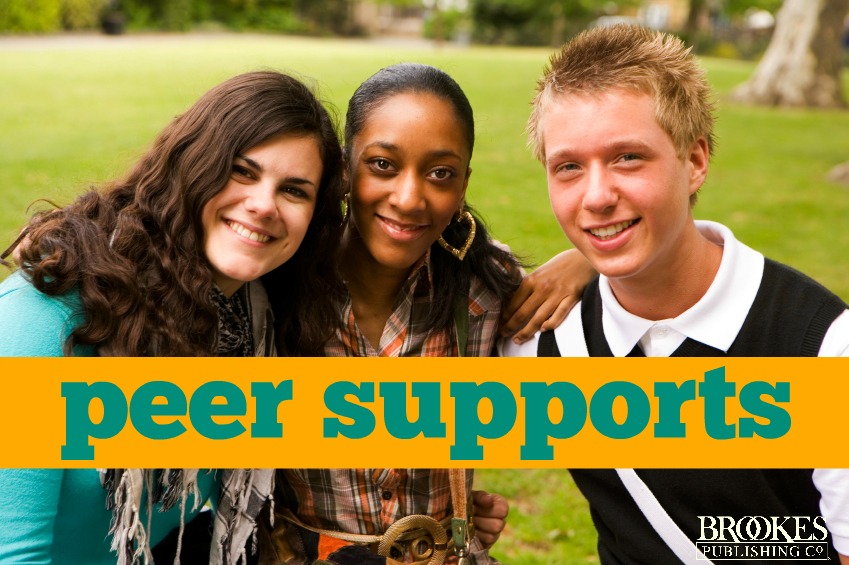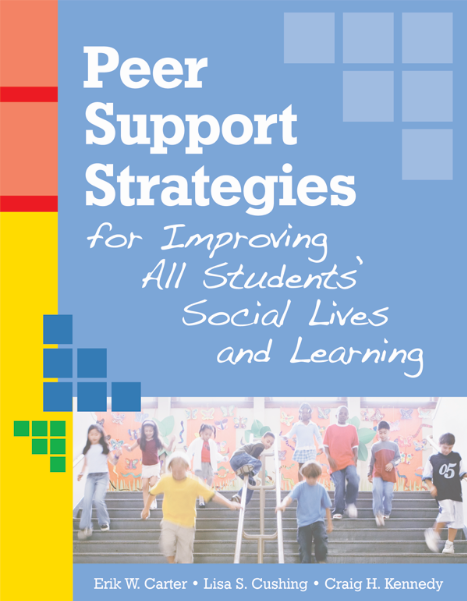10 Practical Principles for Peer Supports: Getting Students Ready to Help
July 7, 2016
Peer supports are one of the most effective ways to help students with disabilities reach their potential and ensure that their academic and social needs are met. Whether you’re implementing a formal peer buddy program or more informal student-to-student partnerships, peer supports don’t have to require a huge time investment–but before you begin, the young people participating will need some preparation and guidance. Today’s post gives you 10 tips on getting students ready to help, so they can provide the most effective, appropriate supports to their peers with disabilities.
TIPS FROM: Peer Support Strategies for Improving All Students’ Social Lives and Learning, by Erik Carter, Lisa Cushing, & Craig Kennedy
Don’t Underestimate Young People
“Adolescents are often capable of much more than adults give them credit for. The current generation of students has grown up attending inclusive schools and classrooms, they are experienced at working collaboratively with others, they are savvy with new technologies and educational innovations, and they recognize their potential role in increasing the participation of their peers with disabilities in everyday school life. In other words, peers often have a good understanding of why inclusion is important and how they can help support it.”
Remain Flexible
“Although students will need some initial orientation to their new roles at the start of the semester and an introduction to basic support strategies, educators can be flexible with how training is provided… Students do not have to learn everything at the outset. Training can often be delivered informally through sharing additional strategies as new needs emerge; modeling appropriate interactions when necessary; or periodically meeting briefly with students before or after class, at lunch, or during down time in class.”
Align Training with Students’ Needs
“Peers are able to provide a rich and diverse array of supports to their classmates with disabilities [see the examples at the end of this post]. Peer support arrangements, however, are individually tailored interventions designed to help address just some of the educational and social support needs of students with severe disabilities in inclusive classrooms. Because support needs vary from student to student and class to class, peers do not need to be taught to provide every conceivable form of support. Rather, they only need to be shown the specific strategies they will need to support a specific classmate.”
Anticipate Potential Challenges and Concerns
“Consider from the outset some of the early questions and concerns students might have [and] make certain that the questions are addressed during orientation activities. Some of the common questions we hear raised by peer supports in our work with schools are as follows:
- What do I do if my partner has behavioral challenges? Is it my role to address these issues?
- What if my partner decides he or she just does not want to work during a particular class?
- Am I responsible for making sure that he or she keeps up with the rest of the class?
- What do I do if I find myself falling behind in my own work? What if I ever feel overwhelmed or unable to keep up?
- What if my partner and I find we do not get along as well as we thought we would?
- Who do I go to if I have questions, need help, or have something I would like to share?
Talk through these or other questions students might have, and brainstorm possible responses before any potential challenges might emerge.”
Model Desired Behaviors
“What attitudes and behaviors do you want peers to adopt? They will learn from watching adults, so it is important to be very aware of how you and your colleagues interact and work with students with disabilities. When adults encourage independence, offer choices, and promote self-determination, peers are likely to mirror these actions. When adults use age-appropriate language, model respectful interactions, and hold high expectations, anticipate that peers will do the same.”
TIPS FROM: Peer Buddy Programs for Successful Secondary School Inclusion, by Carolyn Hughes & Erik Carter
Agree on Expectations
“As a group, teachers and paraprofessionals in a school must meet to discuss and come to consensus regarding roles, responsibilities, and expectations for peer buddies in their particular school. Expectations and roles will vary from school to school, which is why staff should strive to develop their own expectations. For example, in some schools, peer buddies will be expected to accompany their classmates with disabilities to work-study jobs. In other schools, peer buddies will focus more on adapting academic assignments and teaching study skills.”
Clarify Supervisory Roles
“It is important to determine which staff members will be responsible for the day-to-day supervision of peer buddies. For example, in a geography class, peer buddies could be told to go to the general education teacher for academic-related questions but to ask the special education teacher when they have questions about the social behavior of the student with whom they are working. Supervisory roles will differ across schools and even within school settings.”
Maintain Communication
“A contact person should be established for peer buddies in case students need to ask questions or report challenges. This point of contact could be the classroom teacher, club sponsor, lunchroom monitor, special educator, job coach, paraprofessionals, or school counselor. A communication system also must be established for reporting emergencies, such as seizures or accidents.”
Ask Students to Journal about Their Experiences
“We recommend having peer buddies complete daily or weekly reflective journals to record and think about the activities in which they have engaged and interactions they have shared…Such writing prompts students to think about, process, and learn from their experiences as well as improve their skills as a peer buddy. Students’ entries provide teachers with insight into both the successes and challenges that peer buddies are experiencing.”
Give Students Ideas for Specific, Real-World Supports
Here’s a list of 28 small but powerful things peers can do to help students with disabilities inside and outside the classroom:

For more guidance on peer supports, explore the two books quoted in today’s post:
Peer Support Strategies for Improving All Students’ Social Lives and Learning, by Erik Carter, Lisa Cushing, & Craig Kennedy
Peer Buddy Programs for Successful Secondary School Inclusion, by Carolyn Hughes & Erik Carter
KEEP READING






Write a Comment
Your email address will not be published. Required fields are marked *
Post a Comment